APDBD Plasma Polymerized PNIPAm Coatings with Controlled Thickness via Spin Coating Technique
Abstract
1. Introduction
2. Materials and Methods
2.1. Materials
2.2. PNIPAm Films Preparation
2.3. Characterization Methods
3. Results and Discussion
3.1. Plasma Diagnostics
3.2. Influence of Spin Coating Parameters on PNIPAm Film Thickness and Surface Morphology
3.3. Chemical Composition and APDBD Plasma Treatment Time
3.4. Thermal Stability
3.5. Phase Transition Temperature
4. Conclusions
Author Contributions
Funding
Institutional Review Board Statement
Informed Consent Statement
Data Availability Statement
Conflicts of Interest
References
- Gheysoori, P.; Paydayesh, A.; Jafari, M.; Peidayesh, H. Thermoresponsive nanocomposite hydrogels based on Gelatin/poly (N–isopropylacrylamide)(PNIPAM) for controlled drug delivery. Eur. Polym. J. 2023, 186, 111846. [Google Scholar] [CrossRef]
- Deshmukh, S.A.; Sankaranarayanan, S.K.; Suthar, K.; Mancini, D.C. Role of solvation dynamics and local ordering of water in inducing conformational transitions in poly (N-isopropylacrylamide) oligomers through the LCST. J. Phys. Chem. B 2012, 116, 2651–2663. [Google Scholar] [CrossRef] [PubMed]
- de Oliveira, T.E.; Mukherji, D.; Kremer, K.; Netz, P.A. Effects of stereochemistry and copolymerization on the LCST of PNIPAm. J. Chem. Phys. 2017, 146, 034904. [Google Scholar] [CrossRef]
- Throat, S.; Bhattacharya, S. Macromolecular Poly (N-isopropylacrylamide)(PNIPAM) in Cancer Treatment and Beyond: Applications in Drug Delivery, Photothermal Therapy, Gene Delivery and Biomedical Imaging. Adv. Polym. Technol. 2024, 2024, 1444990. [Google Scholar] [CrossRef]
- Narayana, S.; Gowda, B.J.; Hani, U.; Ahmed, M.G.; Asiri, Z.A.; Paul, K. Smart Poly (N-isopropylacrylamide)-Based Hydrogels: A Tour D’horizon of Biomedical Applications. Gels 2025, 11, 207. [Google Scholar] [CrossRef]
- Tamirisa, P.A.; Hess, D.W. Water and moisture uptake by plasma polymerized thermoresponsive hydrogel films. Macromolecules 2006, 39, 7092–7097. [Google Scholar] [CrossRef]
- Turan, E.; Caykara, T. A facile route to end-functionalized poly (N-isopropylacrylamide) brushes synthesized by surface-initiated SET-LRP. React. Funct. Polym. 2011, 71, 1089–1095. [Google Scholar] [CrossRef]
- Vachaudez, M.; D’hooge, D.; Socka, M.; Libiszowski, J.; Coulembier, O.; Reyniers, M.-F.; Duda, A.; Marin, G.; Dubois, P. Inverse dependencies on the polymerization rate in atom transfer radical polymerization of N-isopropylacrylamide in aqueous medium. React. Funct. Polym. 2013, 73, 484–491. [Google Scholar] [CrossRef]
- Kashyap, A.; Singh, N.K.; Soni, M.; Soni, A. Deposition of thin films by chemical solution-assisted techniques. In Chemical Solution Synthesis for Materials Design and Thin Film Device Applications; Elsevier: Amsterdam, The Netherlands, 2021; pp. 79–117. [Google Scholar]
- Maitra, J.; Shukla, V.K. Cross-linking in hydrogels—A review. Am. J. Polym. Sci. 2014, 4, 25–31. [Google Scholar]
- Oryan, A.; Kamali, A.; Moshiri, A.; Baharvand, H.; Daemi, H. Chemical crosslinking of biopolymeric scaffolds: Current knowledge and future directions of crosslinked engineered bone scaffolds. Int. J. Biol. Macromol. 2018, 107, 678–688. [Google Scholar] [CrossRef]
- Carlsson, J.-O.; Martin, P.M. Chemical vapor deposition. In Handbook of Deposition Technologies for Films and Coatings; Elsevier: Amsterdam, The Netherlands, 2010; pp. 314–363. [Google Scholar]
- Wadley, H.; Zhou, X.; Johnson, R.; Neurock, M. Mechanisms, models and methods of vapor deposition. Prog. Mater. Sci. 2001, 46, 329–377. [Google Scholar] [CrossRef]
- Adeoye, A.E.; Adeaga, O.; Ukoba, K. Chemical Vapour Deposition (CVD) and Physical Vapour Deposition (PVD) techniques: Advances in thin film solar cells. Niger. J. Technol. 2024, 43, 479–489. [Google Scholar]
- Mattox, D.M. Physical vapor deposition (PVD) processes. Met. Finish. 2002, 100, 394–408. [Google Scholar] [CrossRef]
- Štěpánková, K.; Müllerová, M.; Žídek, Š.; Pištěková, H.; Urbánek, P.; Sťahel, P.; Trunec, D.; Popelka, A.; Kallingal, N.; Mozetič, M. Plasma Polymerization of Pentane and Hexane for Antibacterial and Biocompatible Thin Films. Plasma Process. Polym. 2025, 22, e2400266. [Google Scholar] [CrossRef]
- Ssekasamba, H.; Tebyetekerwa, M.; Haodong, C.; Balilonda, A.; Ssegwanyi, S.; Gao, Q.; Xiaoliang, T. Review of plasma surface engineering technology toward sustainable textile materials. Mater. Circ. Econ. 2024, 6, 27. [Google Scholar] [CrossRef]
- van de Beek, F. Physics of Dielectric-Barrier Discharge in Gas. Master’s Thesis, TU Delft, Delft, The Netherlands, 2017. [Google Scholar]
- Mishra, R.; Chhabra, M.; Prakash, R. Non-equilibrium cold plasmas and their impacts on physico-chemical properties of food items. Rev. Mod. Plasma Phys. 2025, 9, 16. [Google Scholar] [CrossRef]
- Reuter, S.; Sousa, J.S. Physical Plasma as Source of Reactive Oxygen and Nitrogen Species. In Redox Biology in Plasma Medicine; CRC Press: Boca Raton, FL, USA, 2025; pp. 11–28. [Google Scholar]
- El-Sayed, E.; Hassabo, A.G. Recent advances in the application of plasma in textile finishing (A Review). J. Text. Color. Polym. Sci. 2021, 18, 33–43. [Google Scholar]
- Amorosi, C.; Ball, V.; Bour, J.; Bertani, P.; Toniazzo, V.; Ruch, D.; Averous, L.; Michel, M. One step preparation of plasma based polymer films for drug release. Mater. Sci. Eng. C 2012, 32, 2103–2108. [Google Scholar] [CrossRef]
- Molina, R.; Ligero, C.; Jovančić, P.; Bertran, E. In situ polymerization of aqueous solutions of NIPAAm initiated by atmospheric plasma treatment. Plasma Process. Polym. 2013, 10, 506–516. [Google Scholar] [CrossRef]
- Tang, X.-L.; Guo, S.-M.; Liu, Z.-D.; Tang, R.-Z.; Pang, J.-Y.; Chen, Y. Preparation of thermo-sensitive poly (N-isopropylacrylamide) film using KHz alternating current Dielectric barrier discharge. In Proceedings of the 2017 3rd International Forum on Energy, Environment Science and Materials (IFEESM 2017), Shenzhen, China, 25–26 November 2017; pp. 598–602. [Google Scholar]
- Cui, N.-Y.; Brown, N.M. Modification of the surface properties of a polypropylene (PP) film using an air dielectric barrier discharge plasma. Appl. Surf. Sci. 2002, 189, 31–38. [Google Scholar] [CrossRef]
- Leroux, F.; Campagne, C.; Perwuelz, A.; Gengembre, L. Polypropylene film chemical and physical modifications by dielectric barrier discharge plasma treatment at atmospheric pressure. J. Colloid Interface Sci. 2008, 328, 412–420. [Google Scholar] [CrossRef] [PubMed]
- Liu, C.; Cui, N.; Brown, N.M.; Meenan, B.J. Effects of DBD plasma operating parameters on the polymer surface modification. Surf. Coat. Technol. 2004, 185, 311–320. [Google Scholar] [CrossRef]
- Relvas, C.; Castro, G.; Rana, S.; Fangueiro, R. Characterization of physical, mechanical and chemical properties of quiscal fibres: The influence of atmospheric DBD plasma treatment. Plasma Chem. Plasma Process. 2015, 35, 863–878. [Google Scholar] [CrossRef]
- Satulu, V.; Dinca, V.; Bacalum, M.; Mustaciosu, C.; Mitu, B.; Dinescu, G. Chemistry-induced effects on cell behavior upon plasma treatment of pNIPAAM. Polymers 2022, 14, 1081. [Google Scholar] [CrossRef] [PubMed]
- Liu, Y.; Sakurai, K. Thickness changes in temperature-responsive Poly (N-isopropylacrylamide) ultrathin films under ambient conditions. ACS Omega 2019, 4, 12194–12203. [Google Scholar] [CrossRef]
- Clay, K.; Speakman, S.; Amaratunga, G.; Silva, S. Characterization of a-C: H: N deposition from CH4/N2 rf plasmas using optical emission spectroscopy. J. Appl. Phys. 1996, 79, 7227–7233. [Google Scholar] [CrossRef]
- Pang, J.-Y.; Tang, X.-L.; Shao, M.; Wen, D.; Qiu, G. Spectral Diagnosis of Atmospheric Pressure Plasma Jet. Asian J. Chem. 2014, 26. [Google Scholar] [CrossRef]
- Qiao, K.; Sun, Q.-L.; Yang, X.; Cheng, M.-S.; Guo, D.; Yang, C. Study on the optical emission spectrum diagnosing of the low-temperature plasma using a collisional-radiative model based on the detailed-term-accounting approximation. J. Phys. Conf. Ser. 2021, 1786, 012009. [Google Scholar] [CrossRef]
- Mendhe, A.C. Spin Coating: Easy Technique for Thin Films. In Simple Chemical Methods for Thin Film Deposition: Synthesis and Applications; Springer: Berlin/Heidelberg, Germany, 2023; pp. 387–424. [Google Scholar]
- Lumen Learning. Cohesion and Adhesion in Liquids: Surface Tension and Capillary Action. 2021. Available online: https://courses.lumenlearning.com/suny-physics/chapter/11-8-cohesion-and-adhesion-in-liquids-surface-tension-and-capillary-action/ (accessed on 20 June 2025).
- Duan, Y.; Zhang, Z.; Lu, B.; Chen, B.; Lai, Z. The movement and forces of spinning solution in the nozzle during high-speed centrifugal spinning. J. Eng. Fibers Fabr. 2019, 14, 1558925019828207. [Google Scholar] [CrossRef]
- McIntyre, F.; Sellier, M.; Gooch, S.; Nock, V. Film thickness characterization in dual-axis spin coating of a sphere. Eur. Phys. J. Spec. Top. 2024, 233, 1637–1651. [Google Scholar] [CrossRef]
- Mahmoodi, S.; Guoqing, H.; Khajavi, M.N. Two-dimensional spin coating with a vertical centrifugal force and the effect of artificial gravity on surface leveling. J. Coat. Technol. Res. 2016, 13, 1123–1137. [Google Scholar] [CrossRef]
- Shah, L.A.; Farooqi, Z.H.; Naeem, H.; Shah, S.M.; Siddiq, M. Synthesis and characterization of poly (N-isopropylacrylamide) hybrid microgels with different cross-linker contents. J. Chem. Soc. Pak. 2013, 35, 1522–1529. [Google Scholar]
- Maheswari, B.; Jagadeesh Babu, P.; Agarwal, M. Role of N-vinyl-2-pyrrolidinone on the thermoresponsive behavior of PNIPAm hydrogel and its release kinetics using dye and vitamin-B12 as model drug. J. Biomater. Sci. Polym. Ed. 2014, 25, 269–286. [Google Scholar] [CrossRef] [PubMed]
- Khelifa, F.; Ershov, S.; Habibi, Y.; Snyders, R.; Dubois, P. Use of free radicals on the surface of plasma polymer for the initiation of a polymerization reaction. ACS Appl. Mater. Interfaces 2013, 5, 11569–11577. [Google Scholar] [CrossRef]
- Khelifa, F.; Ershov, S.; Habibi, Y.; Snyders, R.; Dubois, P. Free-radical-induced grafting from plasma polymer surfaces. Chem. Rev. 2016, 116, 3975–4005. [Google Scholar] [CrossRef] [PubMed]
- Wang, H.; Luo, W.; Chen, J. Fabrication and characterization of thermoresponsive Fe3O4@ PNIPAM hybrid nanomaterials by surface-initiated RAFT polymerization. J. Mater. Sci. 2012, 47, 5918–5925. [Google Scholar] [CrossRef]
- Yang, X.; Sun, Z.; Gao, J.; Yang, C.; Tang, D. Plasma-initiated polymerization of N-isopropylacrylamide and functionalized with dopamine for the adhesion to Hela cells. Polym. Bull. 2020, 77, 963–974. [Google Scholar] [CrossRef]
- Shekhar, S.; Mukherjee, M.; Sen, A.K. Studies on thermal and swelling properties of Poly (NIPAM-co-2-HEA) based hydrogels. Adv. Mater. Res. 2012, 1, 269. [Google Scholar] [CrossRef]
- Lotos, E.-D.; Karayianni, M.; Vasiliu, A.-L.; Mihai, M.; Pispas, S. Natural–Synthetic Hybrid Nanostructures Formed Through the Interaction of Chitosan with Carboxylate-Ended PNIPAM: Structure and Curcumin Encapsulation. Nanomaterials 2025, 15, 350. [Google Scholar] [CrossRef]
- Maeda, T.; Yamamoto, K.; Aoyagi, T. Importance of bound water in hydration–dehydration behavior of hydroxylated poly (N-isopropylacrylamide). J. Colloid Interface Sci. 2006, 302, 467–474. [Google Scholar] [CrossRef] [PubMed]
- Parvathy, P.; De, S.; Singh, M.; Manik, G.; Sahoo, S.K. Functional self-healing aldehyde-derived nanoparticle-crosslinked gelatin/PNIPAm-based adhesive gels. RSC Appl. Polym. 2025, 3, 662–674. [Google Scholar] [CrossRef]
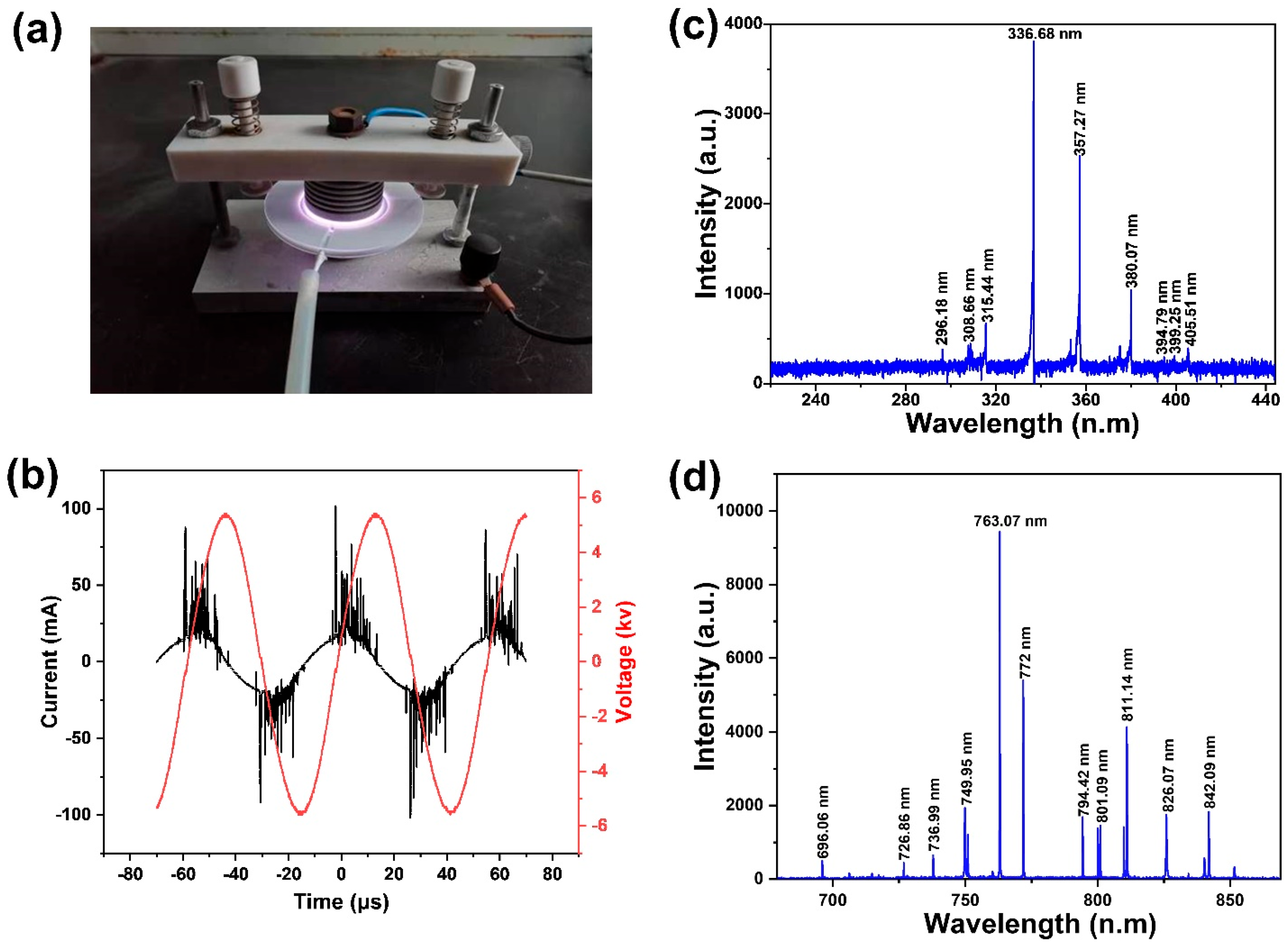
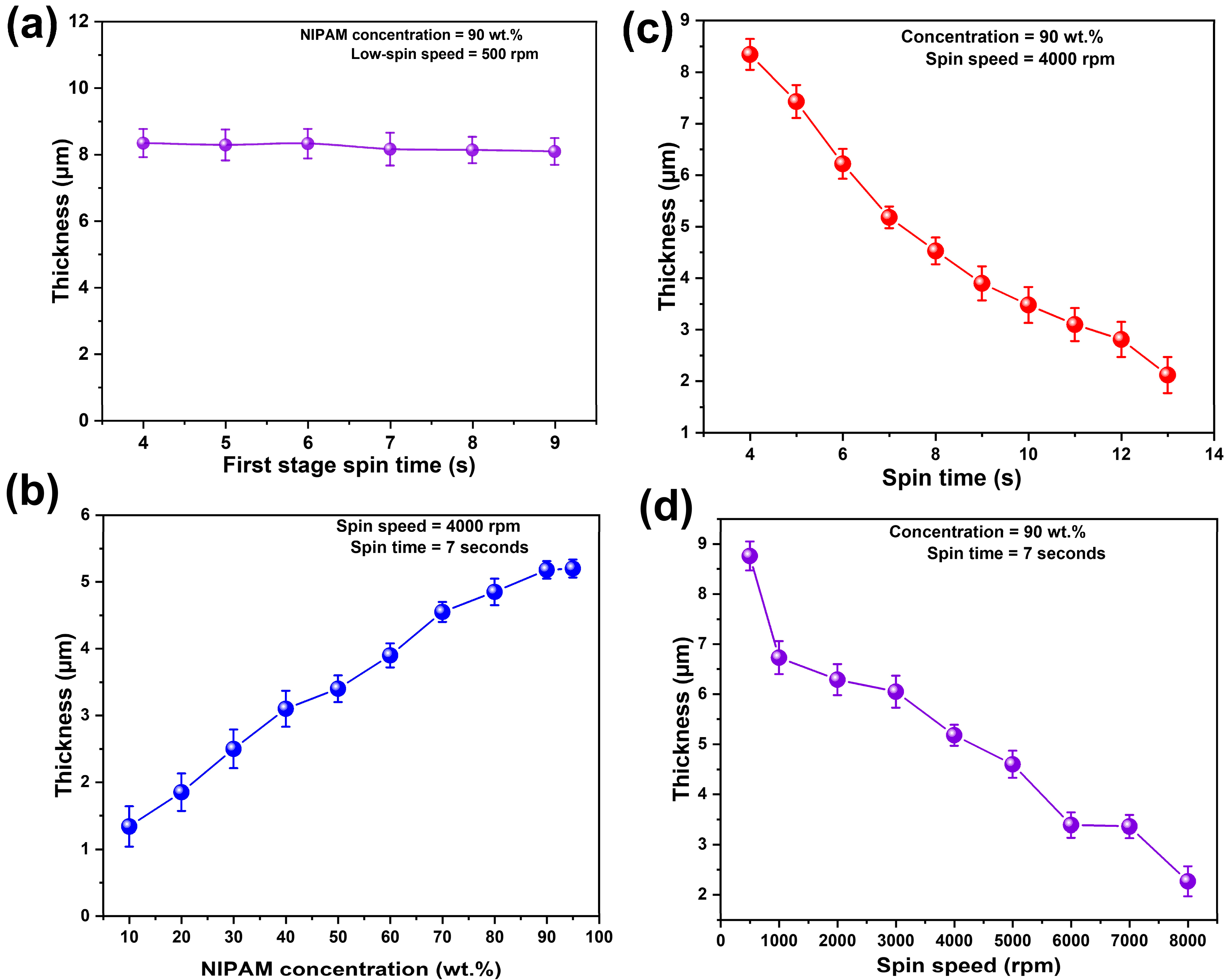
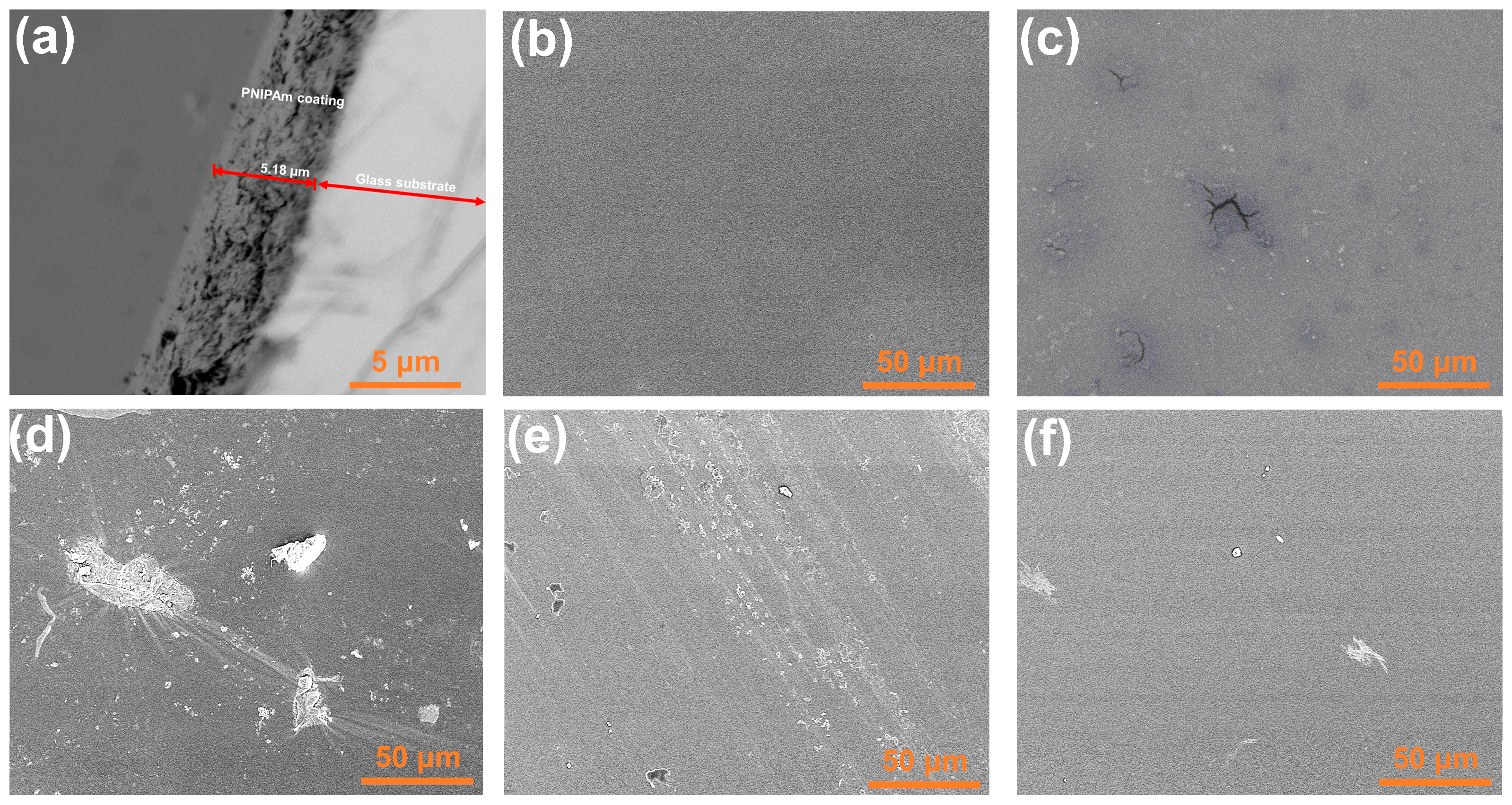
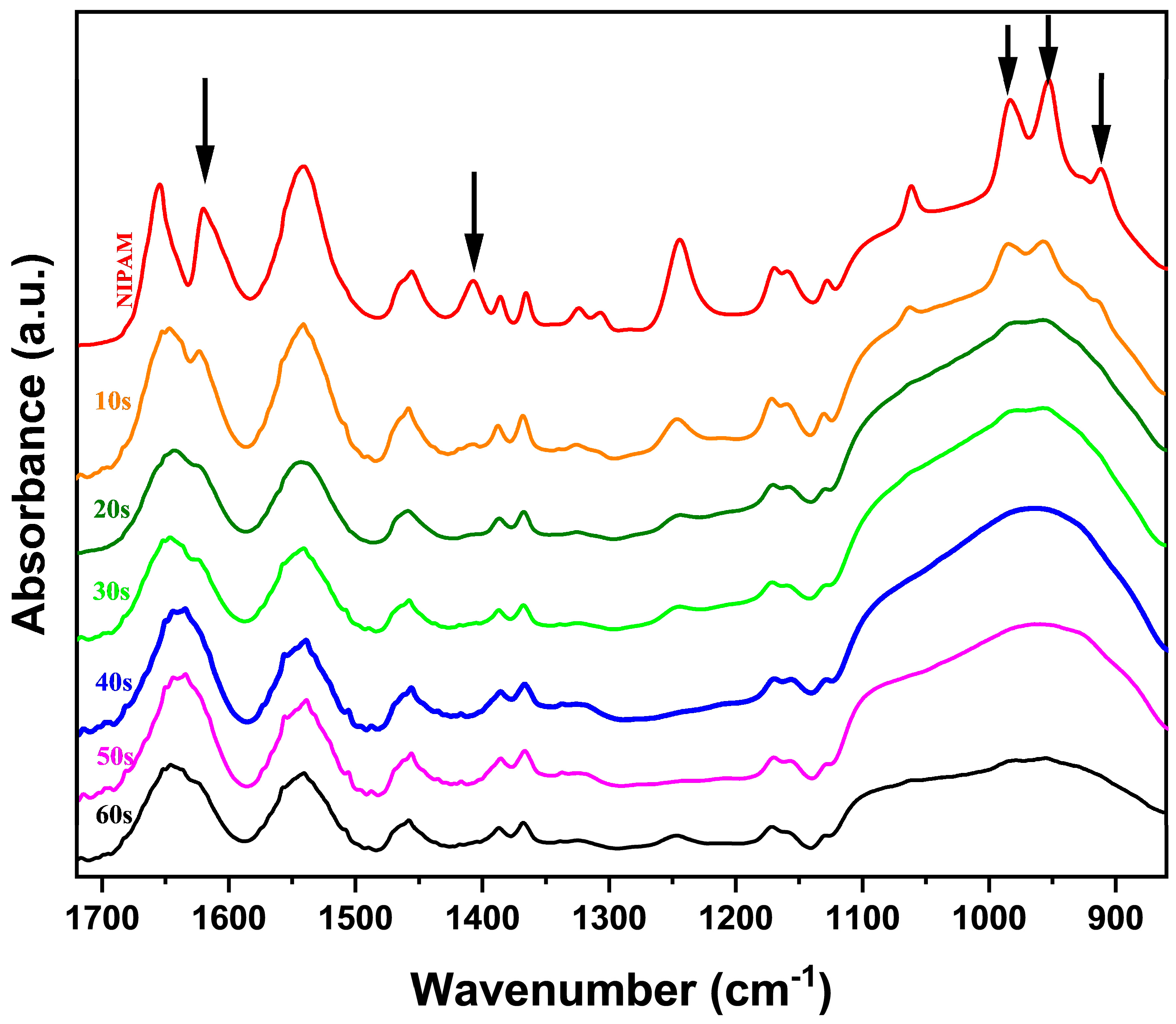

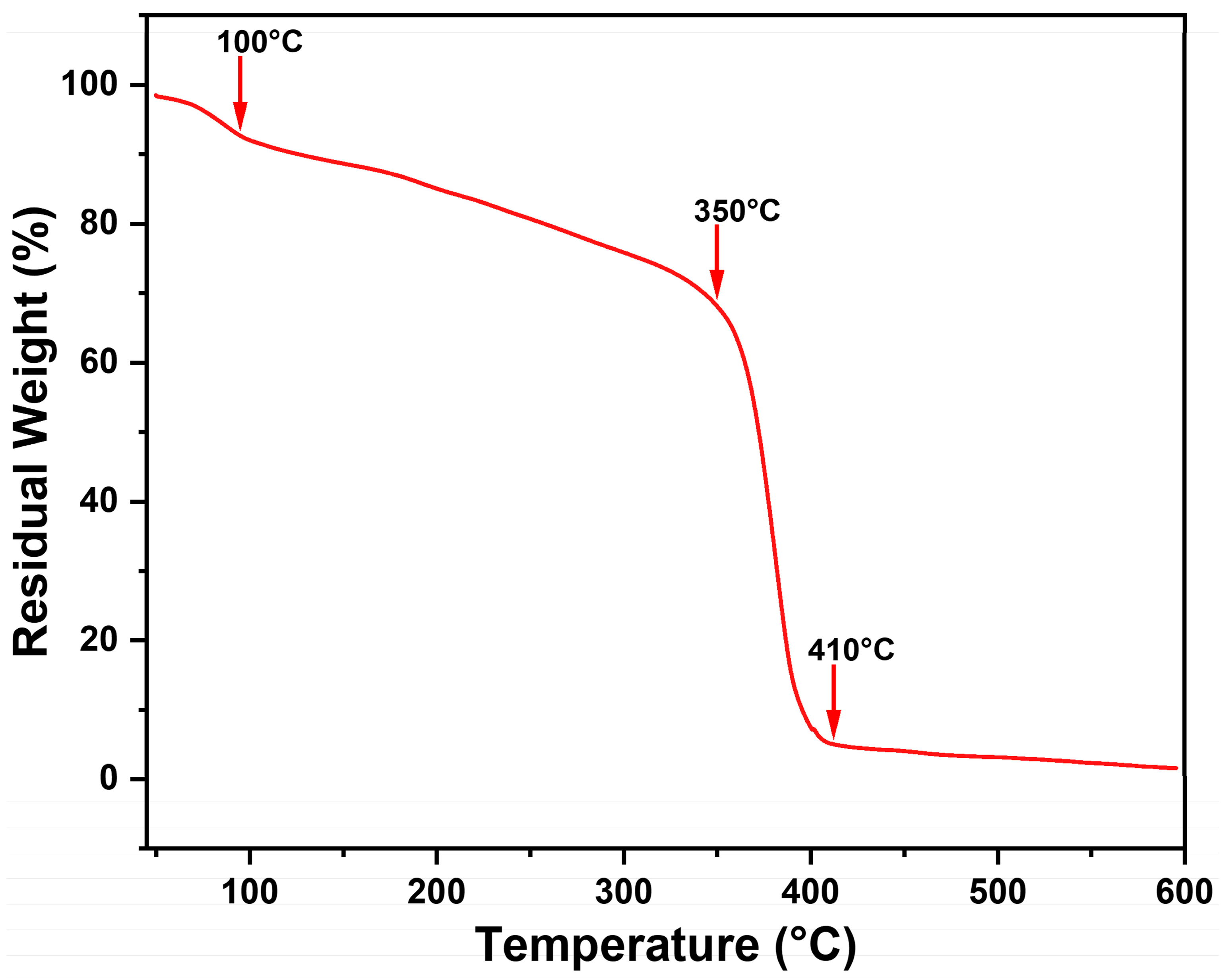
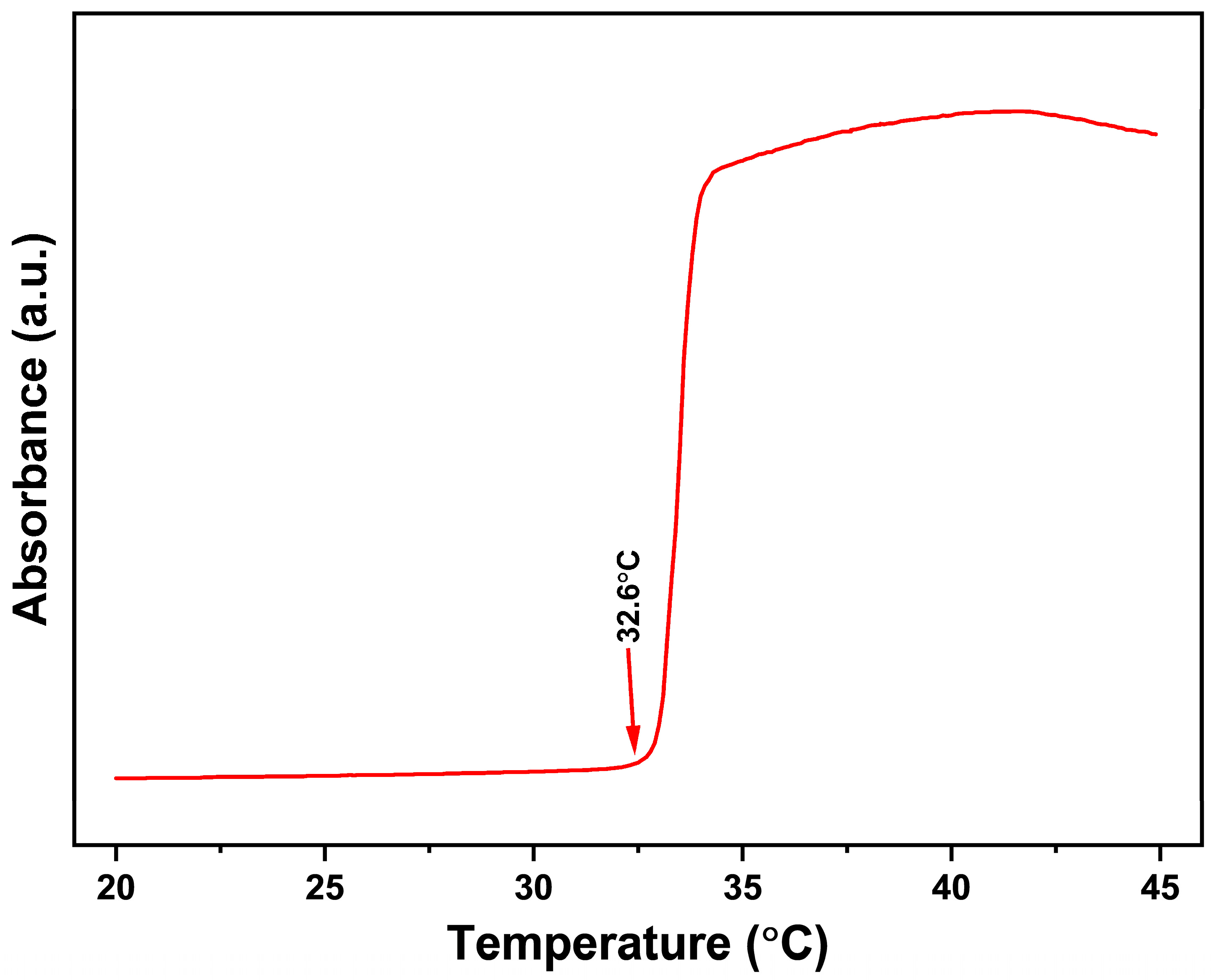
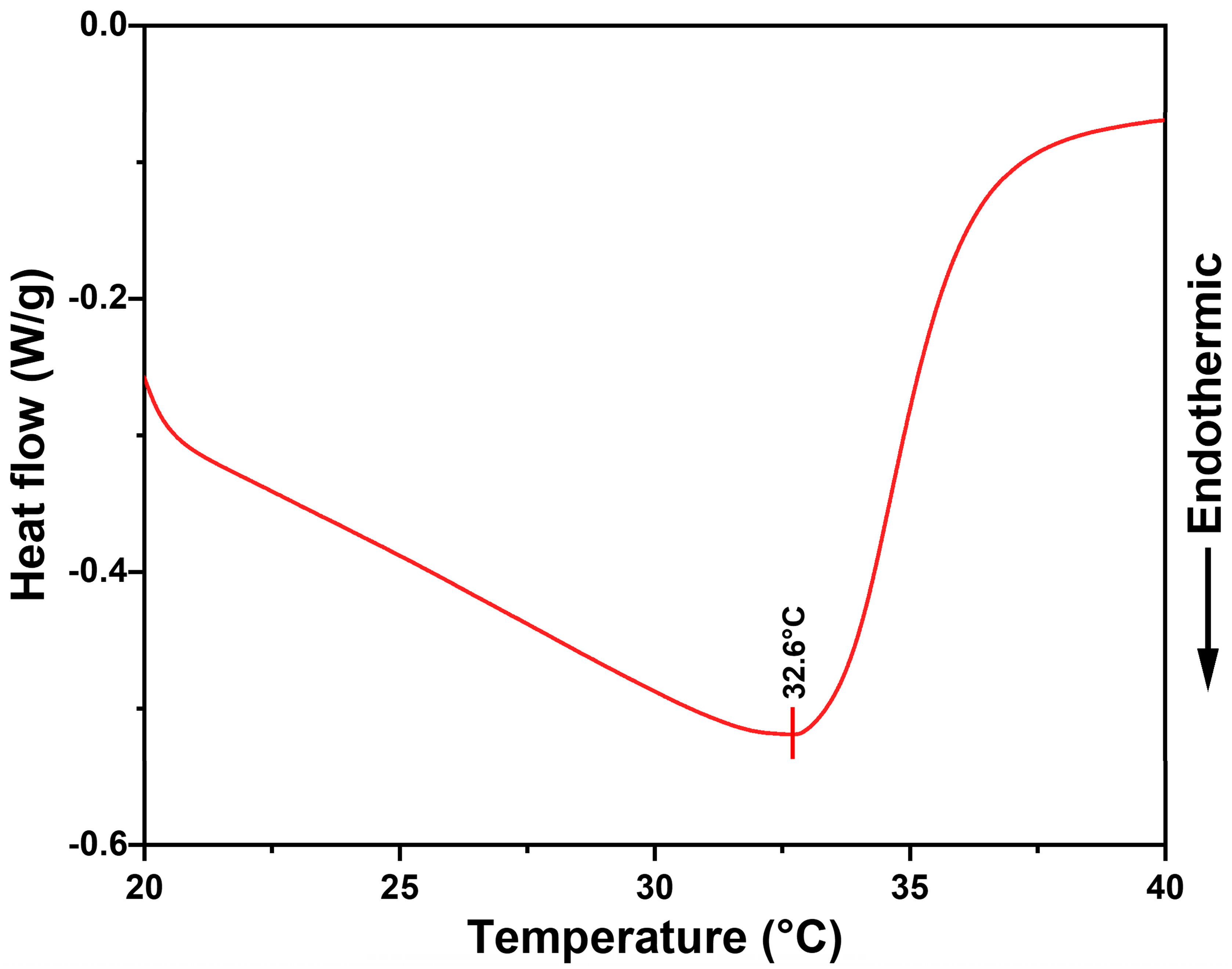
| Spin Coating Parameter | R-Square Value |
|---|---|
| NIPAM concentration | 0.978 |
| Spin speed | 0.946 |
| Spin time | 0.944 |
Disclaimer/Publisher’s Note: The statements, opinions and data contained in all publications are solely those of the individual author(s) and contributor(s) and not of MDPI and/or the editor(s). MDPI and/or the editor(s) disclaim responsibility for any injury to people or property resulting from any ideas, methods, instructions or products referred to in the content. |
© 2025 by the authors. Licensee MDPI, Basel, Switzerland. This article is an open access article distributed under the terms and conditions of the Creative Commons Attribution (CC BY) license (https://creativecommons.org/licenses/by/4.0/).
Share and Cite
Ssekasamba, H.; Chen, X.; Cui, H.; Tang, X.; Qiu, G.; Lu, X.; Yu, Q. APDBD Plasma Polymerized PNIPAm Coatings with Controlled Thickness via Spin Coating Technique. Coatings 2025, 15, 762. https://doi.org/10.3390/coatings15070762
Ssekasamba H, Chen X, Cui H, Tang X, Qiu G, Lu X, Yu Q. APDBD Plasma Polymerized PNIPAm Coatings with Controlled Thickness via Spin Coating Technique. Coatings. 2025; 15(7):762. https://doi.org/10.3390/coatings15070762
Chicago/Turabian StyleSsekasamba, Hakim, Xinwang Chen, Haodong Cui, Xiaoliang Tang, Gao Qiu, Xihua Lu, and Qingsong Yu. 2025. "APDBD Plasma Polymerized PNIPAm Coatings with Controlled Thickness via Spin Coating Technique" Coatings 15, no. 7: 762. https://doi.org/10.3390/coatings15070762
APA StyleSsekasamba, H., Chen, X., Cui, H., Tang, X., Qiu, G., Lu, X., & Yu, Q. (2025). APDBD Plasma Polymerized PNIPAm Coatings with Controlled Thickness via Spin Coating Technique. Coatings, 15(7), 762. https://doi.org/10.3390/coatings15070762







